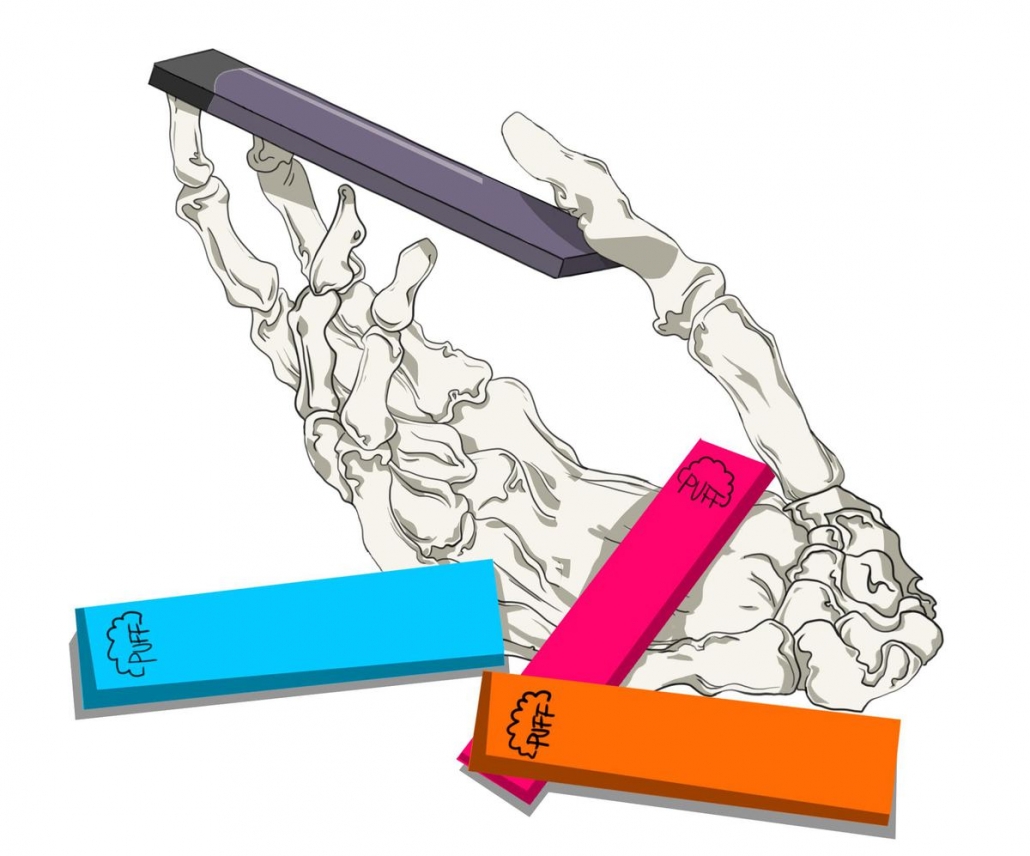Out goes the Juul, in comes the Puff

As the Feb. 6 effective date for the federal flavor ban on electronic cigarettes nears, it feels timely to reflect on the youth vaping epidemic. It came out of left field, baffling the medical community and legislators alike and still shows no signs of turning down the heat. Though Juul Labs, the San Francisco-based company that once dominated the e-cigarette market, has gone under fire for igniting the crisis, you know what they say, when one door closes, another one opens, and young vapers have found that open door in the Puff Bar and other disposable e-cigarettes.
Let’s start from the beginning. In late 2019, a federal survey released by the Food and Drug Administration and Centers for Disease Control and Prevention reported a whopping 25% of the nation’s high school students vaped in the last month, which is up a startling 21% from 2018. These jarring numbers were accompanied by the outbreak of a mysterious vaping-related illness that claimed 59 lives and put 2,602 in the hospital. Thirty nine percent of the afflicted were between the ages of 18 and 24, followed by 15% under 18 — and that’s only in the U.S. so far. Many held the Juul to blame and rightfully so: Its discrete, aesthetic design and kid-friendly flavors, such as mint and mango, were a recipe for illicit underage consumption. When the Trump administration announced in September of last year that it would ban flavored e-cigarettes from the market, many breathed a sigh of relief.
Juul was valued at $38 billion in July; by October, it had lost more than a third of that. The company has only slid further since; Altria, a Marlboro parent company, announced late January that the value of its investment in Juul dropped by more than $4 billion. This all comes at the same time as legal cases against the e-cigarette maker have spiked at 80%. On paper, it looks like a loss for the bad guys and a triumph for the good guys, but that is not the whole story.
The Trump administration decided to prohibit fruit, mint and dessert flavors in refillable cartridge-based e-cigarettes such as Juul, but a policy loophole that went largely unpublicized has now taken center stage. A footnote on page nine of the new policy allows all flavors to continue to be sold in devices that are designed to be disposed of after the nicotine runs dry. This is where the Puff Bar comes into play.
While outside pressure led Juul to discontinue all its flavors except menthol and tobacco, holes in the government’s flavor ban have opened the door to an array of competing brands that produce disposables — blu, Posh, Stig and the infamous Puff Bar to name a few. A Puff Bar, at $7-10 a pop, is more cost-effective than spending almost $30 on a pack of pods and has the same nicotine content. Its design is just as sleek and even more colorful, leaning into the same marketing tactics that got Juul in trouble in the first place. While information about the privately-owned company’s value and profits is scarce, all one has to do is take a look around USC to see that the Puff Bar’s momentum is picking up fast.
The deceptiveness of the Juul lies largely in its aesthetic, and while the same thing holds true for the Puff Bar, there are more layers to consider. There is an insidious nature that is specific to disposable e-cigarettes — namely, the fact that it is far more conducive to an, “Oh, I’ll quit after this one,” mentality than Juul ever was. It seems easy to toss it out when the flavor runs dry and return to a nicotine-free life, until it is not easy at all. It is not a better alternative to the Juul; it is virtually the same thing, with more flavors, more waste and a shorter lifespan.
It seems, then, that this policy was not put in place with the end-all goal of curbing the vaping epidemic but rather to appease both a panicking public and big tobacco giants without making any real sacrifices. The Trump administration did not close the wound the Juul left; it simply put a Band-Aid over a bullet wound and hoped for the best. When Boot Bullwinkle, a spokesperson for the Campaign for Tobacco-Free Kids, expressed: “This policy basically provided a road map for the e-cig industry to continue using flavored products to addict kids,” he was not wrong.
It will not be a surprise when new data shows that youth nationwide are still vaping in masses. The problem has not been mitigated, and it is imperative to call out flimsy legislation at every turn. The magnitude of this epidemic is still to be determined but the integrity of the new policy is not.

